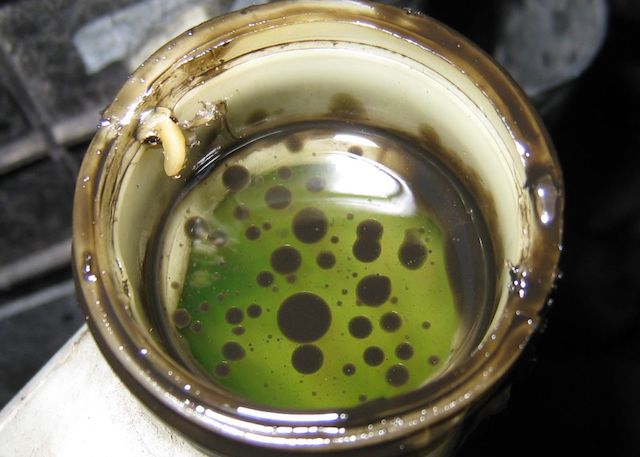Why is There Oil in the Coolant?
This article was originally published on UnderHoodService.com.
When you check the coolant and the fluid looks brownish or milky, it’s likely that the coolant is contaminated with engine oil.
The Main Symptom of Oil in the Coolant
The most common visual symptom of a leak that has been going on for a while is a brown milky sludge in the coolant. In the early stages of a leak, there may just be an oily sheen on top of the coolant. If the owner has missed these symptoms, the car may have overheated.
If the coolant is contaminated with oil, it will need to be flushed and replaced. The root cause of the problem will also have to be repaired. Here are the two most common causes of oil in coolant:

Image Credit: Endolith
1. A Blown Head Gasket
When a head gasket fails, oil can leak into the cooling passages and then end up in the coolant. This results in the brown sludge that can be seen in the top of the radiator, and the coolant reservoir. Oil with coolant in it can also leak into the combustion chamber. This will result in a white cloud of sweet smelling exhaust.
A blown head gasket can be verified with a compression test. If the head gasket is bad, several repairs may need to be done:
- The head gasket, of course, will need to be replaced.
- The entire cooling system will need to be flushed.
- The radiator and water pump should be inspected for leaks or damage. (Cold oil is thicker than water. Pushing cold oil through the radiator and water pump may damage them.)
2. A Failing Oil Cooler
Oil coolers are not very common in gasoline engine vehicles. But turbocharged engines usually have them. If the oil cooler leaks, the main symptom is oil in the coolant. This can cause many people to think that the head gasket is blown. However, a blown head gasket usually affects the engine’s performance. If the oil cooler leaks, the engine will still perform normally.
Fortunately for the customer, an engine oil cooler leak is a much less expensive repair. The oil cooler and it’s gasket will need to be replaced. And the cooling system will need to be flushed and refilled.
Another Coolant Problem – A Leaking Transmission Cooler
Many cars with an automatic transmission have a cooler for the transmission fluid. Often, the transmission cooler is part of the radiator. Cracks can develop between the radiator and the cooler that allow transmission fluid to get mixed into the coolant. This causes the coolant to be pink and foamy looking. The bad news is that the coolant can make its way to the transmission. This can damage the transmission to the point where it needs to be replaced.
MORE CONTENT
Stay current!
Sign up here to get the latest news
and updates on all things GMB.
Sign Up To Receive GMB News & Updates!

